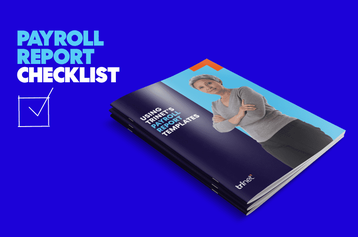
Table of contents
- 1.What is an I-9?
- 2.How to fill out an I-9
- 3.Step 1: Thoroughly read the entire form and instructions
- 4.Step 2: Employee and employer responsibilities
- 5.Step 3: Completely fill out the form
When an employer hires you, they present you with a package that includes any hiring forms you need to fill out, sign, and return to the company. This includes the I-9 employment eligibility form. Employers must document payroll, benefits, taxes, and employment eligibility for regulatory compliance and standard hiring practices. When you are a new employee, it can get overwhelming. The I-9 form is a required federal form that both the new employee and the employer must fill out, with separate sections for each. The employee must present valid current employment eligibility documents, and the employer must examine the documents presented and verify doing so. Both of these must be done within specified timeframes. The employee must complete section 1 and present documents on the first day of work and the employer must complete section 2 within 3 business days of the employee’s start date.
What is an I-9?
The I-9 form is for employment eligibility verification. The United States Citizenship and Immigration Services (USCIS) requires it; employers must have a valid completed I-9 form on file for every employee or face fines and other consequences for violations. The I-9 form is periodically updated when necessary; and the latest update was on May 1, 2020. The I-9 form consists of a:
- 2-page form that the employee and employer should complete
- List of acceptable documents from which to choose
This lists all the I-9 form documents that an employee may choose to present to the employer to prove employment eligibility in the U.S. The I-9 form instructions detail how to fill out the form.
employers must have a valid completed I-9 form on file for every employee or face fines and other consequences for violations.
How to fill out an I-9
Filling out an I-9 form is not difficult, but there are specific requirements about:
- Who fills out which sections (employee and employer)
- What information and documentation is necessary
Unsigned or undated I-9’s are considered incomplete and in violation of federal regulations. I-9s that are not accompanied by the appropriate employment eligibility documents are also considered incomplete. It’s important to fill out the I-9 fully and correctly or the employer may incur penalties and fees. The first part of the form, titled Section 1. Employee Information and Attestation, is what employees fill out. The second part of the form, titled Section 2. Employer or Authorized Representative Review and Verification, is what employers fill out. There is a third part to the form, titled Section 3. Reverification and Rehires. The employer fills it out if an employee’s documentation expires or if they rehire an employee.
Step 1: Thoroughly read the entire form and instructions
After an employee accepts a job offer, they and their employer should complete and sign section 1 of the I-9 form no later than the first day of employment.
After an employee accepts a job offer, they and their employer should complete and sign section 1 of the I-9 form no later than the first day of employment. The form is available to print out or online to fill out digitally. It can’t be signed electronically, however, and must be printed to sign and date by hand. Employees and employers should read through the entire form and instructions first to be sure they understand everything. Employees should also read the definitions of citizenship and immigration status carefully to select and attest to the correct status.
Step 2: Employee and employer responsibilities
Employees should read pages 2 and 3 of the I-9 form carefully and decide which I-9 verification documents to present. The requirement is either one document from List A or one document each from Lists B and List C. A common presentation of documents of U.S. citizens is a driver’s license (a List B document) and a social security card (a List C document). Another common document presentation is a U.S. passport (a List A document). A common presentation of documents of non-U.S. citizens is a driver’s license (a List B document) and an employment authorization document issued by the Department of Homeland Security (a List C document). Another common document presentation of non-U.S. citizens is a foreign passport with Form I-94 or I-94A. Employees should be careful to check that any documents presented are current and not expired, and thus invalid. Employers must physically examine all documents presented for I-9 purposes, and complete and sign section 2 within 3 days of the employee’s first day of work. The dates on the I-9 form are very important and must be accurate:
- The date on section 1 is the employee’s first day of work.
- Check to ensure that the date on section 2 is the same as the employee’s first day of employment on section 1.
- Within 3 business days of the employee’s first day of employment, the employer must complete Section 2.
Step 3: Completely fill out the form
Employees should fill out section 1 completely without markups or corrections. If an error occurs, use a new form and destroy the first one. Review the completed form for accuracy. Then sign and date it before turning it in on the first day of work. Employers should fill out section 2 (or 3 if a rehire or re-verification) completely. The USCIS directs that these sections can have corrections made to them if an error or missing information is discovered. The corrected information should include the date and the initials of the person making the changes. Corrections to I-9 forms should have a written explanation of the correction attached. Remember, the dates on the I-9 form are very important for regulatory compliance. Complete the form within the specified timeframe (on the first day of work) and submit it along with the valid employment eligibility documentation. Per federal regulations, the employer must retain the completed I-9 form for 3 years after the date of hire or one year after the date employment ends.
This article is for informational purposes only, is not legal, tax or accounting advice, and is not an offer to sell, buy or procure insurance. TriNet is the single-employer sponsor of all its benefit plans, which does not include voluntary benefits that are not ERISA-covered group health insurance plans and enrollment is voluntary. Official plan documents always control and TriNet reserves the right to amend the benefit plans or change the offerings and deadlines.
This article may contain hyperlinks to websites operated by parties other than TriNet. Such hyperlinks are provided for reference only. TriNet does not control such web sites and is not responsible for their content. Inclusion of such hyperlinks on TriNet.com does not necessarily imply any endorsement of the material on such websites or association with their operators.

TriNet Team
Table of contents
- 1.What is an I-9?
- 2.How to fill out an I-9
- 3.Step 1: Thoroughly read the entire form and instructions
- 4.Step 2: Employee and employer responsibilities
- 5.Step 3: Completely fill out the form





